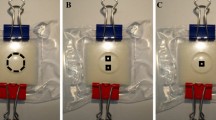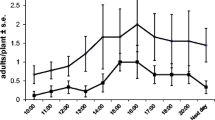Abstract
Aggregative responses by the predatory mites, Phytoseiulus persimilis, Typhlodromus occidentalis, and Amblyseius andersoni (Acari: Phytoseiidae), to spatial variation in the density of mobile stages of Tetranychus urticae (Acari: Tetranychidae) were studied over different spatial scales on greenhouse roses. Significant spatial variations in prey numbers per leaflet, per leaf, per branch or per plant were present in all experimental plots. None of the predator species responded to prey numbers per plant, and all searched randomly among plants. Within a plant, the oligophagous P. persimilis searched randomly among branches, but aggregated strongly among leaves within a branch and among leaflets within a leaf. The narrowly polyphagous T. occidentalis searched randomly among leaflets within a leaf and amond leaves within a branch, but aggregated strongly among leaflets or leaves within a plant. The boradly polyphagous A. andersoni searched randomly among leaflets within a leaf, a branch or a plant, and among leaves within a branch or a plant, but distributed themselves more often on branches with lower prey densities. Thus, specialist predators aggregate strongly at lower spatial levels but show random search at higher spatial levels, whereas generalist predators show random search at lower spatial levels but aggregate at higher spatial levels. This is the first empirical evidence demonstrating the relation between the degree of polyphagy and the spatial scale of aggregation. It is also concluded that both the prey patch size (i.e. grain) and predator foraging range (i.e. extent) are important for analyzing spatial scales of predator aggregation. The importance of studying spatial scale of aggregation is also discussed in relation to predator-prey metapopulation dynamics.
Similar content being viewed by others
References
Addicott JF, Aho JM, Antolin MF, Padilla DK, Richardson JS, Soluk DA (1987) Ecological neighborhoods: scaling environmental patterns. Oikos 49: 340–346
Beddington JR, Free CA, Lawton JH (1978) Characteristics of successful natural enemies in models of biological control of insect pests. Nature 273: 513–519
Boys FF, Burbutis PP (1972) Influence of Phytoseiulus persimilis on populations of Tetranychus turkestani at the economic threshold on roses. J Econ Entomol 65: 114–116
Burnett T (1979) An acarine predator-prey population infesting roses. Res Popul Ecol 20: 227–234
Cook RM, Hubbard SF (1977) Adaptive searching stragies in insect parasites. J Anim Ecol 46: 115–125
Dicke M, Groeneveld A (1986) Hierarchical structure in kairomone preference of the predatory mite Amblyseius potentillae: dietary component indispensable for diapause induction affects prey location behaviour. Ecol Entomol 11: 131–138
Driessen G and Hemerik L (1991) Aggregative responses of parasitoids and parasitism in populations of Drosophila breeding in fungi. Oikos 61: 96–107
Elliott NC, Simmons GA, Haynes DL (1986) Mortality of pupae of jack pine budworm (Lepidoptera: Tortricidae) parasites and density dependence of hyperparasitism. Environ Entomol 25: 662–668
Eveleigh ES, Chant DA (1982a) The searching behaviour of two species of phytoseiid mites, Phytoseiulus persimilis Athias-Henriot and Amblyseius degenerans (Berlese), in relation to the density and distribution of prey in an homogeneous area (Acarina: Phytoseiidae). Can J Zool 60: 648–658
Eveleigh ES, Chant DA (1982b) Experimental studies on acarine predator-prey interactions: the distribution of search effort and the functional and numerical responses of predators in a patchy environment (Acarina: Phytoseiidae). Can J Zool 60: 2979–2991
Eveleigh ES, Chant DA (1982c) Experimental studies on acarine predator-prey interactions: effects of temporal changes in the environment on searching behaviour, predation rates, and fecundity (Acarina: Phytoseiidae). Can J Zool 60: 2992–3000
Eveleigh ES, Chant DA (1982d) Experimental studies on acarine predator-prey interactions: the distribution of search effort and predation rates of a predator population in a patchy environment (Acarina: Phytoseiidae). Can J Zool 60: 3001–3009
Fernando MHJP, Hassell MP (1980) Predator-prey responses in an acarine system. Res Popul Ecol 22: 301–322
Field RP, Hoy MA (1986) Evaluation of genetically improved strains of Metaseiulus occidentalis (Nesbitt) (Acarina: Phytoseiidae) for integrated control of spider mites on roses in greenhouse. Hilgardia 54: 1–31
Force DC, Moriarty DJ (1988) Effects of patch scale on density-dependence and species-dependence in two host-parasitoid systems. Oecologia 76: 439–444
Freeman BE, Smith DC (1990) Variation of density-dependence with spatial scale in the leaf-mining fly Liriomyza commelinae (Diptera: Agromyzidae). Ecol Entomol 15: 265–274
Jones TH, Hassell MP (1988) Patterns of parasitism by Trybliographa rapae, a cynipid parasitoid of the cabbage root fly, under laboratory and field conditions. Ecol Entomol 13: 309–317
Hassell MP (1978) The dynamics of arthropod predator-prey systems. Princeton University Press, Princeton, New Jersey
Hassell MP, May RM (1974) Aggregation of predators and insect parasites and its effects on stability. J Anim Ecol 43: 567–594
Heads PA, Lawton JH (1983) Studies on the natural enemy complex of the holly leaf-miner: the effects of scale on the detection of aggregative responses and the implications for biological control. Oikos 40: 267–276
Hoy MA, Smilanick JM (1981) Non-random prey location by the phytoseiid predator Metaseiulus occidentalis: Differential responses to several spider mite species. Ent Exp Appl 29: 241–253
Lapchin L (1991) Spatial heterogenity and density dependence in wheat aphids and their natural enemies. Redia 74: 223–230
McMurtry JA, Scriven GT (1965) Insectary production of phytoseiid mite. J Econ Entomol 58: 282–284
McMurtry JA, Rodriguez JG (1987) Nutritional ecology of phytoseiid mites. In: F Slansky Jr, JG Rodriguez (eds), Nutritional Ecology of Insects, Mites and Spiders. John Wiley & Sons, Inc. New York, pp. 609–644
Murdoch WW, Reeve JD, Huffaker CB, Kennett CE (1984) Biological control of olive scale and its relevance to ecological theory. Am Nat 123: 371–392
Reeve JD (1990) Stability, variability, and persistence in hostparasitoid systems. Ecology 71: 422–426
Reeve JD, Murdoch WW (1985) Aggregation by parasitoids in the successful control of the California red scale: a test of theory. J Anim Ecol 54: 797–816
Rose GA, Leggett WC (1990) The importance of scale to predatorprey spatial correlations: an example of Atlantic fishes. Ecology 71: 33–43
Rosenheim JA, Meade T, Powch IG, Schoenig SE (1989) Aggregation by foraging parasitoids in response to local variations in host density: determining the dimensions of a host patch. J Anim Ecol 58: 101–117
Rothman LD, Darling DC (1990) Parasitoids of the goldenrod gall moth: effects of scale on spatial density dependence. Oecologia 83: 1–6
Rothman LD, Darling DC (1991) Spatial density dependence: effects of scale, host spatial pattern and parasitoid reproductive strategy. Oikos 62: 221–230
Ruberson JR, Tauber MJ, Tauber CA, Gollards B (1991) Parastization by Edovum puttleri (Hymenoptera: Eulophidae) in relation to host density in the field. Ecol Entomol 16: 81–89
Sabelis MW (1981) Biological control of two-spotted spider mite using phytoseiid predators. Agricultural Research Report 910. Pudoc, Wageningen
Sabelis MW, Diekmann O (1988) Overall population stability despite local extinction: The stabilizing influence of prey dispersal from predator-invaded patches. Theor Popul Biol 34: 169–176
Sabelis MW, Diekmann O, Jansen VAA (1991) Metapopulation persistence despite local extinction: predator-prey patch models of Lokta-Volterra type. Biol J Linn Soc 42: 267–283
Schmidt G (1986) Der Einfluss der von den Beutetieren hinterlassenen Spuren auf Suchverhalten und Sucherfolg von Phytoseiulus persimilis Athias-Henriot (Acarina: Phytoseiidae). Ztsch Ang Ent 82: 216–218
Southwood TRE (1978) Ecological methods, with particular reference to the study of insect populations. Second edition. Chapman and Hall, London
Stiling P, Throckmorton A, Silvanima J, Strong DR (1991) Does spatial scale affect the incidence of density dependence? A field test with insect parasitoids. Ecology 72: 2143–2154
Strong DR (1989) Density independence in space and inconsistent temporal relationships for host mortality caused by a fairyfly parasitoid. J Anim Ecol 58: 1065–1076
Takafuji A, Chant DA (1976) Comparative studies of two species of predacious phytoseiid mites (Acarina: Phytoseiidae), with special reference to their responses to the density of their prey. Res Popul Ecol 17: 255–310
Taylor AD (1990) Metapopulations, dispersal, and predator-prey dynamics: An overview. Ecology 71: 429–433
Waage JK (1979) Foraging for patchily-distributed hosts by the parasitoid, Nemeritis canescens. J Anim Ecol 48: 353–371
Wiens JA (1989) Spatial scaling in ecology. Func Ecol 3: 385–397
Zhang ZQ (1993) Foraging behavior and ecology of three acarine predator species with different degrees polyphagy (Acari: Phytoseiidae). Ph. D. Dissertation, Cornell University, Ithaca
Zhang ZQ, Sanderson JP (1992) Short-distance location of spider mite colonies by three predatory mites (Acari: Tetranychidae, Phytoseiidae): Predator responses to prey-and predator-associated stimuli. Environ Entomol 21: 799–807
Zhang ZQ, Sanderson JP, Nyrop JP (1992) Foraging time and spatial patterns of predations: A comparative study of three mite predator-prey systems (Acari: Phytoseiidae, Tetranychidae). Oecologia 90: 185–196
Author information
Authors and Affiliations
Rights and permissions
About this article
Cite this article
Zhang, ZQ., Sanderson, J.P. Spatial scale of aggregation in three acarine predator species with different degrees of polyphagy. Oecologia 96, 24–31 (1993). https://doi.org/10.1007/BF00318026
Received:
Accepted:
Issue Date:
DOI: https://doi.org/10.1007/BF00318026




